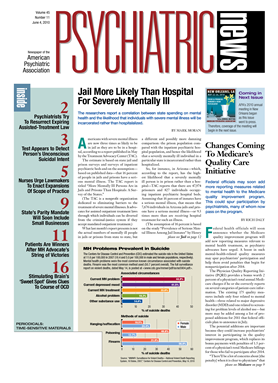Daily repetitive transcranial magnetic stimulation (TMS) to the left prefrontal lobe was more effective than placebo in inducing remission from major depression.
This was a key finding published in the May Archives of General Psychiatry, which reported the acute-phase results of the Optimization of TMS for Depression Trial (OPT-TMS).
When in the acute phase, 190 patients with major depressive disorder were randomly assigned to active or sham TMS treatment five days a week for three weeks. At the end of the three weeks, patients who achieved remission were tapered off and placed on medications, although those who had sufficient improvement but no remission continued with the assigned treatment for up to another three weeks. Patients without sufficient improvement were switched to an unblinded treatment phase of the study that lasted for up to six weeks.
All patients remained free of antidepressant, antipsychotic, or antiepileptic medications for two weeks before the treatment started and during the study treatment.
Sufficient improvement was defined as at least a 30 percent reduction in Hamilton Depression Rating Scale (HAM-D) score from baseline. Remission was defined as having a HAM-D score of 3 or less in one assessment or two consecutive HAM-D scores of less than 10. Patients were administered the HAM-D twice a week by independent raters who were not involved in providing the TMS treatment.
During this acute phase, 18 patients achieved remission, eight of whom did so in the first three weeks of treatment; six of those eight patients had active TMS and two had sham treatment. Ten other patients achieved remission during weeks 4 to 6, including seven who had active TMS and three who had sham TMS.
Based on an intent-to-treat analysis, 14 percent of patients in the active TMS treatment arm (n=92) met the remission criteria. This was significantly higher than the 5 percent remission rate in the sham treatment arm (n=98). The number needed to treat was 12.
Among the 144 patients who did not show sufficient improvement in the first three weeks and were switched to the open-label treatment phase, 43 (30 percent) met the remission criteria during the open treatment.
The treatment was well tolerated, the researchers noted, and the rate of adverse events did not differ between active TMS and sham treatment groups. No seizure or suicidal events occurred. Headache was the most common adverse event, reported by 32 percent of patients on active TMS and 23 percent on sham treatment.
Evidence Supplements Industry Trial
The study was conducted at four research sites: Medical University of South Carolina, Columbia University College of Physicians and Surgeons/New York State Psychiatric Institute, University of Washington, and Emory University.
A commercial TMS device was approved by the Food and Drug Administration (FDA) in the fall of 2008 based on one clinical trial (Psychiatric News, November 21, 2008). The current study was funded by the National Institute of Mental Health.
“The TMS device we used in this study was the same as the device that was used in the clinical trial that led to the FDA approval,” Sarah Lisanby, M.D., one of the study authors, told Psychiatric News. “The output of that device is essentially the same as the currently marketed model of the device.” Lisanby is director of the Division of Brain Stimulation and Therapeutic Modulation and a professor of clinical psychiatry at Columbia. She was also an investigator in the previous, company-sponsored study.
In the new study, the active TMS treatment was given at 10-Hz pulses in four-second periods, with a 26-second interval between periods. Each session lasted 37.5 minutes. Thus, the total dose administered per session was 3,000 pulses.
Previous research on TMS drew criticisms that sham controls may not adequately resemble active treatment, so that participants and study staff could guess who was undergoing active or “fake” treatment; thus, the efficacy data may be “contaminated.” In the OPT-TMS trial, the sham control was devised to mimic the pulsing sensation to the scalp and the sound of the TMS device during administration.
The study patients, treatment administrators, and independent raters were blinded to the treatment randomization. Patients, administrators, and raters were asked to guess the treatment assignments, and their responses confirmed that the blinding method was effective.
TMS Works for Low-Resistance Patients
Secondary analyses of the study data showed that patients with a history of low resistance to antidepressant medications were more likely to remit during TMS treatment. The study enrolled adult patients who had had insufficient clinical response to one to four courses of antidepressant medications and whose current depressive episode was less than five years in length.
In the industry trial that led to FDA approval, “we analyzed the predictors of response to TMS and found that TMS was more effective than sham only in patients who had failed to respond to a single antidepressant medication in the current depressive episode,” Lisanby explained. “TMS did not differ from sham in those patients who were more medication resistant.”
That earlier study was published in the January 2009 Neuropsychopharmacology.
“TMS is indicated early in the course of illness,” Lisanby concluded. “Available evidence does not support its use later in the course, after patients have failed multiple medications.”
